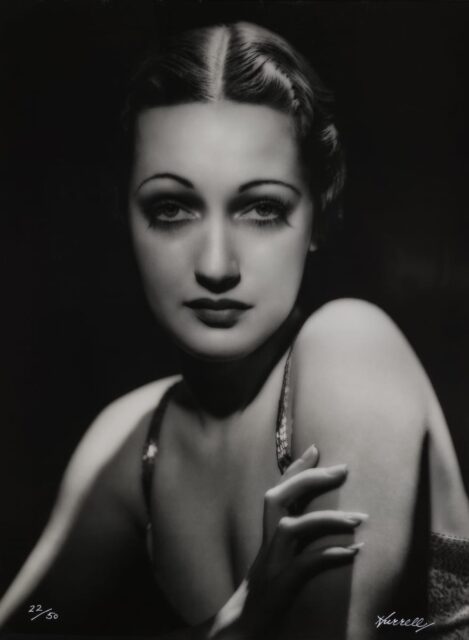Dorothy Lamour, 1935
George Hurrell (American, b. 1904)
Gelatin silver print
48 x 36 in
Rarely do I speedwalk the halls of Chambers, inevitably late to a class, and find myself halted in place by what decorates the walls. Dorothy Lamour as posed in print on the first floor of the building immediately captured me. This piece personifies the essence of 1930s silver-screen glamour photography in all its glory, with the subject appearing god-like in her beauty.
Dorothy models a low-neck sequin gown, dramatic eye makeup, and dark finger-waved hair, all characteristic of her status and time. Contrasts between the highlights of her face and the darkness of the background pull focus to her sultry features and draw the viewer in. She sits next to another print, Johnny Weissmuller, an Olympic-level swimmer who later found a career in acting. Both Lamour and Weissmuller appear to be carved from glowing marble, an affect achieved by soft lenses and Hurrell’s painstaking process of hand-retouching each negative.
George Hurrell is the defining pioneer of the old Hollywood glamour shot, characterized by its romantic air and dramatic lighting that sculpts the subject. He began his artistic journey in the Chicago Art Institute studying fine painting, a discipline that introduced him to the camera only as a means of creating reference photos before he found his aptitude for beauty photography. This technical background allowed Hurrell to master concepts of composition and approach the lens with a unique eye, seeking ways to sophisticate his subjects.
Marilyn Monroe, Joan Crawford, Clark Gable, and Roman Novarro are among the stars that graced Hurrell’s studio in his nearly six-decade career. His techniques were instrumental in establishing the ideals of golden age portraiture as an art form, and in turning actors into veritable movie stars.
-Audrey Cobb ’25

